
Become a member
Join today and help protect nature, beauty and history – for everyone, for ever. Enjoy access to more than 500 places with National Trust membership.
Ancient abbey ruins and an awe-inspiring water garden at this World Heritage Site
Fountains, Ripon, North Yorkshire, HG4 3DY

| Asset | Opening time |
|---|---|
| Abbey and water garden admission | 10:00 - 16:00 |
| Gift shop & plant centre | 10:30 - 16:30 |
| Visitor centre restaurant | 09:30 - 16:00 |
| Ticket type | With Gift Aid | Without Gift Aid |
|---|---|---|
| Adult (18+) | £23.10 | £21.00 |
| Child (5-17) under 5s free | £11.60 | £10.50 |
| Family (2 Adults and up to 3 children) | £57.80 | £52.50 |
| 1 Adult, up to 3 children | £34.70 | £31.50 |
| Group (Adult 18+) | £19.95 | |
| Group (Child 5-17) | £9.98 |
Find a big adventure playground less than two minutes from the visitor centre. There are things to wobble along, jump over and climb on. You'll find a wooden abbey, scrambling nets, posts, swings and a five point harness swing for younger visitors with additional access needs.
An audio guide is available from the visitor centre admissions desk.
Main car park at the visitor centre is free of charge. Studley car park is pay & display (free for NT members) £7 for 4 hours, £10 all day. West Gate for accessible parking and level access to the abbey and water garden. No overnight parking. Please don't park in the local village as this causes an obstruction for residents and emergency vehicles.
Cycle parking is located outside Visitor Centre Admissions and next to Fountains Hall, 100m from the West Gate entrance. There are water bottle filling stations in the visitor centre courtyard.
Dogs very welcome in all outdoor spaces, but please keep them on a short lead at all times. They're also welcome in admissions, the shop, and visitor centre restaurant.
Dogs allowed - more information12 11kW electric vehicle charging points are available in Car Park A. Chargers can be accessed using mobile app, RFID card, or contactless payment device. Visit our EV charging partner, RAW Charging's website to download the app before your visit. Chargers are only available to visitors during property opening hours. Drivers must bring their own cables.
Electric vehicle charging point - more informationYear-round tours of the abbey and water gardens. Tours are subject to volunteer availability.
Guided tour - more informationRefreshment kiosk in the Studley tea-room garden and Mill café. Check with the welcome team for daily opening times.
Kiosk - more informationBring a picnic rug and enjoy a picnic with views of the abbey and water garden. Picnic tables can be found opposite the the play area all year round or on the grassy lawn at the Visitor Centre in summer.
A large National Trust gift shop and plant centre is located at the visitor centre.
Plant shop - more informationRestaurant at the visitor centre serving hot and cold food and drinks with indoor and outdoor seating.
Restaurant - more informationA large National Trust gift shop and plant centre is located at the visitor centre.
Shop - more informationToilets at each entrance to the estate and in the Studley car park.
There is a steep 15-20% gradient from the visitor centre to the abbey. This is not recommended for wheelchair or powered mobility vehicle users. Our accessible car park is located at our West Gate entrance (SatNav search - 'West Gate car park') which allows level access to the abbey and water gardens through which there are recommended routes. We want to make sure that as many people as possible can enjoy Fountains Abbey and Studley Royal. If you'd like to discuss any arrangements we can make to meet your access needs please give us a call on (01765) 608888 and we'll do our best to help.
There is a steep 15-20% gradient from the visitor centre to the estate. This is not recommended for wheelchair or powered mobility vehicle users. Our accessible car park is located at our West Gate entrance and allows level access to the grounds.
Accessible route and/or map - more informationAccessible toilets are located at the visitor centre, near the West Gate and Studley entrances, in the tea-room garden and in the Studley car park.
Our accessible car park is located near our West Gate entrance (Sat Nav postcode HG4 3DZ). This provides level access to the abbey and water gardens.
Induction loops are available at all till points. We also have a portable induction loop available to hire, free of charge, for guided tours. Pre-booking is essential, please call 01765 608888. Please collect from your tour guide at Porter's Lodge.
There's level access to the visitor centre restaurant from the visitor centre car park. Studley Tea Rooms and Mill Kiosk are on level access from inside the estate.
There are some slopes and cobbles on the accessible route. Access to the abbey is across a level grassy green. When the grass is particularly wet this can be impassable for wheelchairs, mobility scooters and prams. Some paths on site are surfaced with loose hardcore. Higher paths in the water garden and deer park are reached via steep slopes.
There is a lift to the upper levels of Fountains Mill.
A limited number of wheelchairs and mobility scooters are available to hire, free of charge. They can be collected between 10.30am and 11.30am and must be return by 4pm. Pre-booking is essential, please call 01765 608888. Please collect from the West Gate entrance upon arrival.
Powered mobility vehicle available - more informationThere are some gentle and steep slopes around the estate. Please be aware of uneven ground, height drops and deep running water. We recommend wearing sturdy shoes when you visit.
There is a complimentary visitor transport service which operates between all three entrances to the estate from 10am-4pm. Please ask a member of staff to call this for you if you'd like to make use of it.
Visitor Centre Car Park A entrance - what3words: ///subsets.parsnip.panther
Discover Christmas 2025 at Fountains Abbey and Studley Royal. Wrap up warm and grab a mulled drink or a festive treat. Immerse yourself in the Christmassy atmosphere and as the afternoon light starts to fade, wander through the glowing abbey ruins.
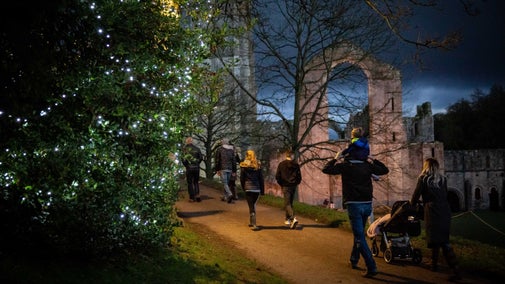

Fountains Abbey is a three pawprint rated place. Discover why it's such a great place to bring your dog and take a look at our top tips to help you make the most of your visit.

We want to make sure that Fountains Abbey and Studley Royal is accessible for all visitors. Discover how we can help you make the most of your visit to Fountains Abbey and Studley Royal.
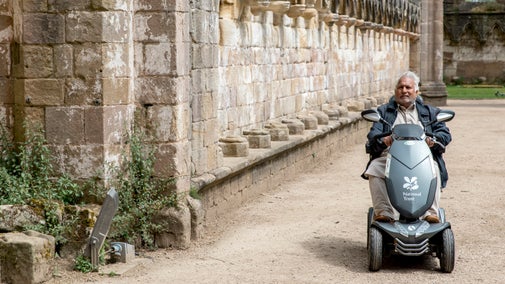
Discover the benefits of group visits to Fountains Abbey and Studley Royal, the huge programme of educational activities available for school groups, how to book and more.

From engagement shoots to blockbuster movies, and everything in between - read on for some helpful guidance about photography and filming at Fountains Abbey.

Find out all about our special events. From guided tours and exhibitions to school holiday fun!

Step into a world of Christmas creativity with our Toymaker’s Workshop, perfect for little crafty hands and make a real wooden toy to take home!
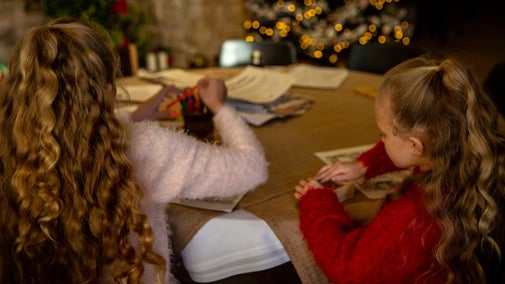
This UNESCO World Heritage Site is a unique place made of two moments in history. Where medieval strength blends with 18th century eccentricity to create a landscape full of secrets, curiosities and breathtaking views.
One of the largest and best preserved ruined Cistercian monasteries in England. Explore vaulted ceilings, grand columns and an imposing tower.
The garden at Studley Royal is one of the best surviving examples of a Georgian water garden in England. The elegant ornamental lakes, canals, temples and cascades provide a succession of dramatic eye-catching vistas.
Over 300 red, sika and fallow deer call this extensive parkland home. The deer park also includes St Mary's Church, one of the finest examples of high Victorian gothic revival architecture in England, designed by William Burges.
Discover Christmas 2025 at Fountains Abbey and Studley Royal. Wrap up warm and grab a mulled drink or a festive treat. Immerse yourself in the Christmassy atmosphere and as the afternoon light starts to fade, wander through the glowing abbey ruins.


Find out more about all of our upcoming events. From guided tours and exhibitions to school holiday fun!

This UNESCO World Heritage Site is a unique place made of two moments in history. Where medieval strength sits side by side with 18th century eccentricity to create a landscape full of secrets, curiosities and breath-taking views.
Helpful tips if you’re planning a visit to Fountains Abbey & Studley Royal with babies and children
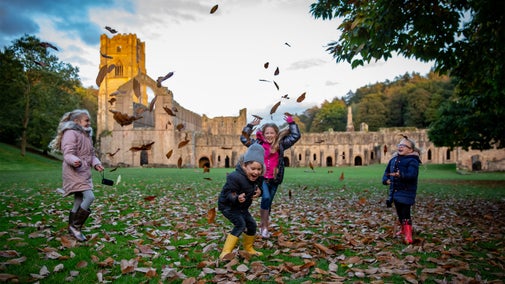
The ruins of Fountains Abbey are truly something to behold. Discover what to see when you come face to face with some of the oldest abbey ruins in the country.

The evocative ruins of the abbey are set beside the grounds of Studley Royal, a medieval deer park in Yorkshire. It was declared Yorkshire’s first World Heritage Site in 1986.

Break up your adventures at Fountains Abbey and Studley Royal with some tasty refreshments. Afterwards, look for the perfect gift or a treat for yourself in the National Trust shop and plant centre.

On this circular walk, you'll cross delightful arched bridges as you follow the meandering Skell river.
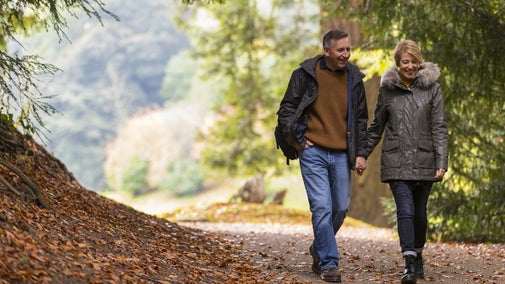
Follow this circular route trail to marvel at the 300 wild deer that live within the Studley Royal deer park in North Yorkshire.

See all the highlights of Fountains Abbey and Studley Royal on a circular walk, taking in the Abbey ruins, hall, deer park and 18th-century water garden.
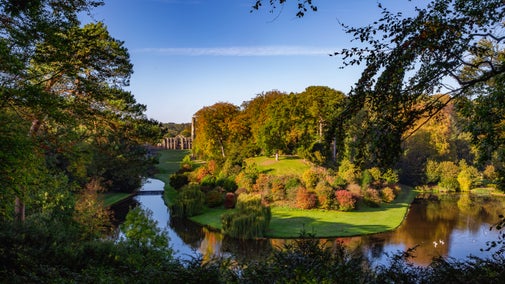
Explore the highlights of the park on this circular walk and learn more about the ancient trees in the deer park and insights into the 18th-century landscape.
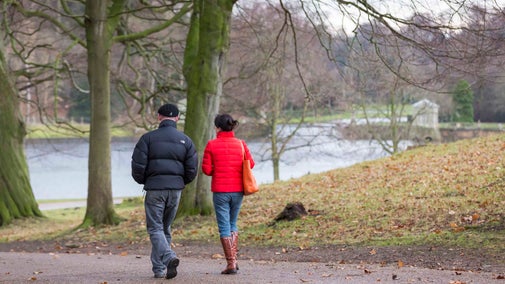
Learn more about the 18th-century landscape of the Deer Park and the Seven Bridges Valley on this 5-mile circular walk at Fountains Abbey.

Walk to Fountains Abbey and Studley Royal from Ripon, taking in cathedral views from the lime avenue through the deer park, then explore the Seven Bridges Valley on your return.
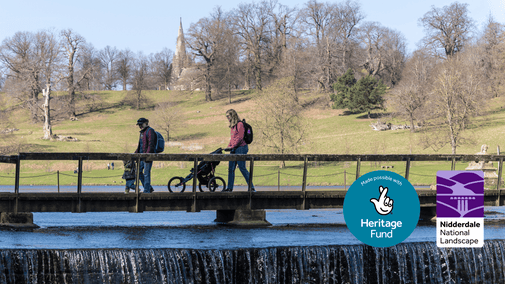
Head into Ripon, search for wildlife and follow in the footsteps of soldiers on the Hell Wath Nature Trail.
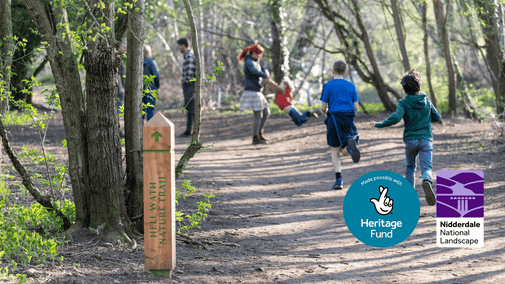

A large house located on the Fountains Abbey estate designed by a famous name, with a unique style.

Three spacious floors to explore, an ivy-clad exterior and Fountains Abbey just moments away.

Moments away from Fountains Abbey, this characterful cottage has lots of original features.

An eclectic history and stylish interiors with walks along the river to Fountains Abbey.

This former cow shed is now a comfortable holiday home less than a mile from Fountains Abbey.

A stylish third-floor apartment in the beautiful Fountains Hall with views of the river Skell.

A fine period apartment based in a grand hall that has played host to some very royal guests…

Discover the spectacular ruins of Fountains Abbey from this large cottage with a farmhouse air.
A new immersive exhibition by Ed Kluz comes to Fountains Hall from summer to winter solstice 2025.
Trot along to St Mary's Church to watch the wild deer munching through their winter feed. See some antlers up close and chat to the wildlife team.
Step into a world of festive magic on the Christmas Toymaker’s Trail.
Take part in a Christmas workshop with the Toymaker, perfect for little crafty hands.
Join one of our volunteer tour guides to discover more about the largest monastic ruins in the country.
Join one of our volunteer tour guides to discover the secrets and surprises of Studley Royal Water Garden, a UNESCO World Heritage Site
Get into the festive spirit with seasonal music and colourful lighting in the cellarium.
Head to Swanley Grange and find a collection of traditional games for all ages, ready for you to pick up and play.
For centuries people have been drawn to this inspiring place.
From humble beginnings the magnificent abbey was established by devout monks seeking a simpler existence. The atmospheric ruins that remain are a window into a way of life which shaped the medieval world.
When the socially ambitious John Aislabie inherited Studley Royal, he set about creating an elegant water garden of mirror-like ponds, statues and follies, incorporating the romantic ruins into his design.
Green lawns stretch down to the riverside, a perfect spot for a picnic. Riverside paths lead to the deer park, home to Red, Fallow and Sika deer and ancient trees; limes, oaks, and sweet chestnuts.
One-of-a-kind, this special place is now recognised as a World Heritage Site.
Step back into a dramatic past and imagine what life would have been like for the monks lived here, and learn how Fountains Abbey and Studley Royal became one.

Find out how Fountains Abbey and Studley Royal became a UNESCO World Heritage Site in 1986 and how we're preserving its unique features for future generations to enjoy.

Follow our progress as we undertake a £4.6 million project to improve the experience at Fountains Abbey and Studley Royal for everyone.

The Skell Valley Project concluded in May 2025. Working with 16 partners including farmers, landowners and local communities, read more about how the scheme delivered a series of projects over the last four years to help create a sustainable future for the Skell Valley.
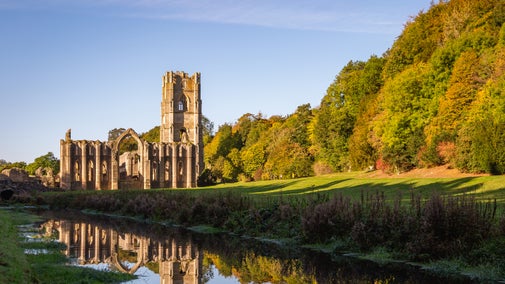
Dive into some of the past conservation projects at Fountains Abbey and Studley Royal, Yorkshire, aimed at restoring the vision of John and William Aislabie.
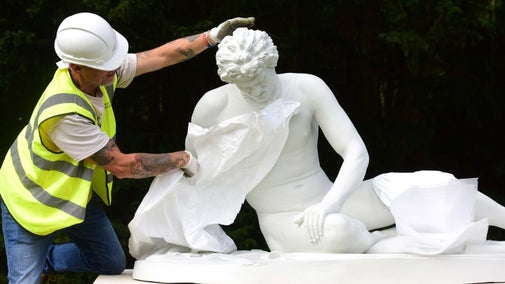
Fountains Abbey and Studley Royal is home to many species of wildlife, including birds and deer. Find out how we support the wildlife living across the estate.

Find out how you can join the volunteering team at Fountains Abbey and Studley Royal and play an important role in the smooth running of this UNESCO World Heritage Site.


Join today and help protect nature, beauty and history – for everyone, for ever. Enjoy access to more than 500 places with National Trust membership.
By sharing your email address you’re agreeing to receive marketing emails from the National Trust and confirm you’re 18 years old or over. Please see our for more information on how we look after your personal data.